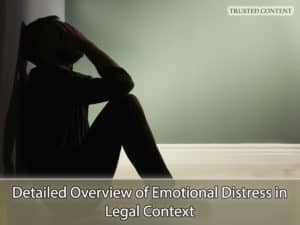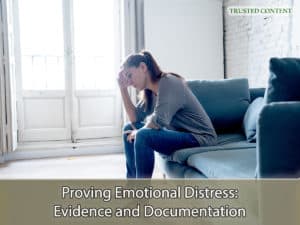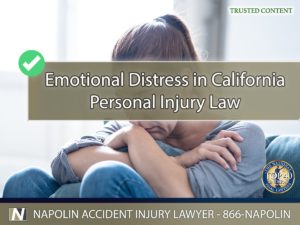Understanding the Role of Emotional Distress in California Personal Injury Law
In the realm of personal injury law in California, emotional distress is a pivotal yet often underappreciated aspect. This article delves into the intricacies of emotional distress within the legal landscape of California, highlighting its importance in personal injury claims. We aim to provide a comprehensive understanding of how emotional distress is evaluated and compensated in the state, offering insights into the legal processes and the rights of those affected.

Detailed Overview of Emotional Distress in Legal Context
Detailed Overview of Emotional Distress in Legal Context
Emotional distress in California personal injury law is recognized as a non-physical injury that can have profound psychological effects on an individual. It encompasses a range of emotional and mental disturbances, including anxiety, depression, fear, and even PTSD, which can arise from various traumatic experiences. California law acknowledges that these psychological impacts are as significant as physical injuries and provides avenues for victims to seek compensation.
Legal Standards for Emotional Distress Claims in California
In California, the legal standards for claiming emotional distress are stringent and require substantial proof. The victim must demonstrate that the emotional distress is significant and more than just fleeting or trivial. This often involves providing evidence of the severity and duration of the emotional impact, which can be substantiated through medical records, psychological evaluations, and personal testimony. The law differentiates between negligent and intentional infliction of emotional distress, each with its own legal criteria and burden of proof.
Types of Emotional Distress: IIED and NIED
Emotional distress in personal injury cases is categorized into two types: Intentional Infliction of Emotional Distress (IIED) and Negligent Infliction of Emotional Distress (NIED). IIED occurs when an individual's actions are deliberate and cause severe emotional suffering. In contrast, NIED pertains to cases where emotional distress results from someone's negligence, without the intent to cause harm. Both categories require distinct approaches in legal argumentation and evidence presentation.

Proving Emotional Distress- Evidence and Documentation
Proving Emotional Distress: Evidence and Documentation
Proving emotional distress in a personal injury claim is a complex process that demands comprehensive evidence. Victims are required to present detailed medical and psychological reports that illustrate the extent of their emotional distress. Additionally, journals, personal diaries, and testimonies from family, friends, or coworkers can provide further insight into the daily impact of the emotional trauma. Legal representation plays a crucial role in compiling and presenting this evidence effectively.
Emotional Distress Across Various Injury Scenarios
The manifestation of emotional distress varies significantly across different types of personal injury cases. In auto accidents, victims may experience a range of emotional reactions, from shock and disbelief to long-term anxiety and fear of driving. Workplace injuries can lead to chronic stress, loss of enjoyment in life, and feelings of helplessness. Each scenario presents unique challenges in proving and quantifying emotional distress.
Compensation for Emotional Distress in California
California law allows victims of emotional distress to seek compensation, which is assessed based on the impact of the distress on the individual's life. This compensation can cover various aspects, including therapy costs, loss of enjoyment of life, and pain and suffering. The calculation of these damages is complex and often requires expert testimony to establish the full extent of the emotional impact.
Challenges in Emotional Distress Claims and Overcoming Them
Claimants of emotional distress face several challenges, such as proving the direct link between the incident and their emotional state and the subjective nature of emotional injuries. Overcoming these challenges requires a strategic legal approach, including gathering robust evidence and expert testimonies. An experienced personal injury lawyer can navigate these complexities, ensuring that the victim's emotional suffering is acknowledged and compensated.
Napolin Accident Injury Lawyer: Advocating for Your Rights
At Napolin Accident Injury Lawyer, we understand the profound impact emotional distress can have on an individual's life. Our approach to personal injury claims is holistic, considering both the physical and emotional aspects of your experience. We are committed to advocating for your rights and ensuring that you receive the comprehensive representation you deserve.

Understanding the Role of Emotional Distress in California Personal Injury Law
Understanding the Role of Emotional Distress in California Personal Injury Law
Emotional distress is a significant yet often overlooked aspect of personal injury claims in California. Understanding your rights and the complexities of the law is crucial in these cases. If you are experiencing emotional distress due to an injury, it is essential to seek professional legal assistance. Contact Napolin Accident Injury Lawyer at (866)-NAPOLIN for a free consultation. With our extensive experience in personal injury law, we are dedicated to helping you navigate your claim and secure the compensation you deserve for both your physical and emotional injuries.
- Safely and Legally Navigating Parking Lots in California - July 15, 2024
- Navigating the Aftermath of a Highway Auto Accident in California - July 15, 2024
- An Overview of California's Commercial Truck Insurance Laws - July 15, 2024
